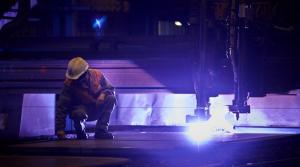In the forges of ITER
Men of the Iron Age, long before the term was coined, accidently discovered that by adding a bit of carbon to molten iron, a harder and more durable metal was created—steel.

Three thousand years have gone by and steel is still at the centre of our civilization. World production passed 1.5 billion tons in 2013—a factor of fifty increase over the early 1900s.
But today's steel is a far cry from the one produced in Iron Age kilns. Although the basic recipe hasn't changed (iron and a small amount of carbon), manufacturers are capable of producing wide palette of grades—steel manufacturing today often resembles the elaboration of a sophisticated perfume, where fragrances are combined to realize the desired effect. Steelmakers in France, in fact, have borrowed the word "nuance" from the perfume industry to characterize the variety of grades they produce.
According to the specific needs of each customer, the chemical composition of the steel can be adjusted: steel for an automobile, for example, is different from the one used in the metal structure of a building; steel for a high-speed train rail has very little in common with the one chosen for a water cistern.
And some customers, some activities, require an even greater level of sophistication ...
At the Industeel-Le Creusot plant in central France (a business unit of the global giant Arcelor-Mittal), some 450 different grades are available. At the top of the line are the steels that will be used in ITER components. From the first mockups and prototypes produced in 2004 for the ITER vacuum vessel, to orders on the books today from companies with ITER contracts in Korea, India, Russia and Europe, the steelworks in Le Creusot has booked some 10,000 tons of steel plate in a dozen different grades and ranging in thickness from 5 to 150 millimetres.
These specialized steels must meet ITER's demanding functional, safety and technological requirements. Some will be exposed to ultra-hot plasma and high vacuum, others to the extreme cold of the cryogenic fluid. Some must be completely permeable to magnetic fields; others, on the contrary, must act to influence them...
It's all a matter of chemistry: a good dose of chromium prevents oxidation; a small percentage of nitrogen improves mechanical properties; a zest of titanium, niobium or molybdenum increases resistance to corrosion; and boron can be added for better neutron absorption—an essential quality for certain ITER components.
And if chemistry is important, manufacturing processes also play an important role in the final product. "The Korean company SFA Engineering Corp, responsible for manufacturing the thermal shield system for ITER, will add a thin layer of silver to the plates that we supply," explains Jean-Christophe Gagnepain, the sales manager at Industeel-Le Creusot. "The quality of this layer depends on the quality of the plate's surface, and ultimately on our production expertise."
Industeel-Le Creusot has already shipped 5,000 tons of stainless steel plates to India, 3,500 tons each to Japan and Korea, and 300 tons to Russia, where they'll become a part of the ITER vacuum vessel, cryostat, thermal shield or magnet system.
In a rural area of central France, a steelworks founded in the early years of the 19th century is helping to meet the challenges of one of the most complex machines of the 21st.


